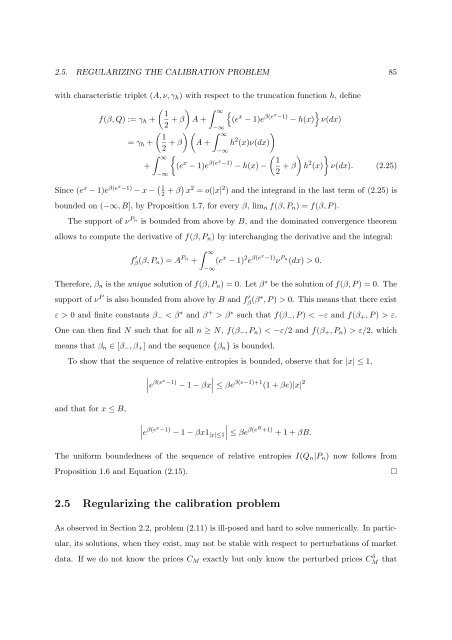Processus de Lévy en Finance - Laboratoire de Probabilités et ...
Processus de Lévy en Finance - Laboratoire de Probabilités et ...
Processus de Lévy en Finance - Laboratoire de Probabilités et ...
You also want an ePaper? Increase the reach of your titles
YUMPU automatically turns print PDFs into web optimized ePapers that Google loves.
2.5. REGULARIZING THE CALIBRATION PROBLEM 85<br />
with characteristic tripl<strong>et</strong> (A, ν, γ h ) with respect to the truncation function h, <strong>de</strong>fine<br />
( ) ∫ 1 ∞<br />
f(β, Q) := γ h +<br />
2 + β A +<br />
−∞<br />
( ) ( 1<br />
= γ h +<br />
2 + β A +<br />
∫ ∞<br />
+<br />
−∞<br />
∫ ∞<br />
−∞<br />
{<br />
(e x − 1)e β(ex −1) − h(x) −<br />
{<br />
}<br />
(e x − 1)e β(ex−1) − h(x) ν(dx)<br />
)<br />
h 2 (x)ν(dx)<br />
( ) }<br />
1<br />
2 + β h 2 (x) ν(dx). (2.25)<br />
Since (e x − 1)e β(ex −1) − x − ( 1<br />
2 + β) x 2 = o(|x| 2 ) and the integrand in the last term of (2.25) is<br />
boun<strong>de</strong>d on (−∞, B], by Proposition 1.7, for every β, lim n f(β, P n ) = f(β, P ).<br />
The support of ν Pn<br />
is boun<strong>de</strong>d from above by B, and the dominated converg<strong>en</strong>ce theorem<br />
allows to compute the <strong>de</strong>rivative of f(β, P n ) by interchanging the <strong>de</strong>rivative and the integral:<br />
f ′ β (β, P n) = A Pn +<br />
∫ ∞<br />
−∞<br />
(e x − 1) 2 e β(ex −1) ν Pn (dx) > 0.<br />
Therefore, β n is the unique solution of f(β, P n ) = 0. L<strong>et</strong> β ∗ be the solution of f(β, P ) = 0. The<br />
support of ν P is also boun<strong>de</strong>d from above by B and f ′ β (β∗ , P ) > 0. This means that there exist<br />
ε > 0 and finite constants β − < β ∗ and β + > β ∗ such that f(β − , P ) < −ε and f(β + , P ) > ε.<br />
One can th<strong>en</strong> find N such that for all n ≥ N, f(β − , P n ) < −ε/2 and f(β + , P n ) > ε/2, which<br />
means that β n ∈ [β − , β + ] and the sequ<strong>en</strong>ce {β n } is boun<strong>de</strong>d.<br />
To show that the sequ<strong>en</strong>ce of relative <strong>en</strong>tropies is boun<strong>de</strong>d, observe that for |x| ≤ 1,<br />
∣<br />
∣e β(ex−1) − 1 − βx∣ ≤ βe β(e−1)+1 (1 + βe)|x| 2<br />
and that for x ≤ B,<br />
∣<br />
∣e β(ex −1) − 1 − βx1 |x|≤1<br />
∣ ∣∣ ≤ βe<br />
β(e B +1) + 1 + βB.<br />
The uniform boun<strong>de</strong>dness of the sequ<strong>en</strong>ce of relative <strong>en</strong>tropies I(Q n |P n ) now follows from<br />
Proposition 1.6 and Equation (2.15).<br />
2.5 Regularizing the calibration problem<br />
As observed in Section 2.2, problem (2.11) is ill-posed and hard to solve numerically. In particular,<br />
its solutions, wh<strong>en</strong> they exist, may not be stable with respect to perturbations of mark<strong>et</strong><br />
data. If we do not know the prices C M exactly but only know the perturbed prices C δ M that
















